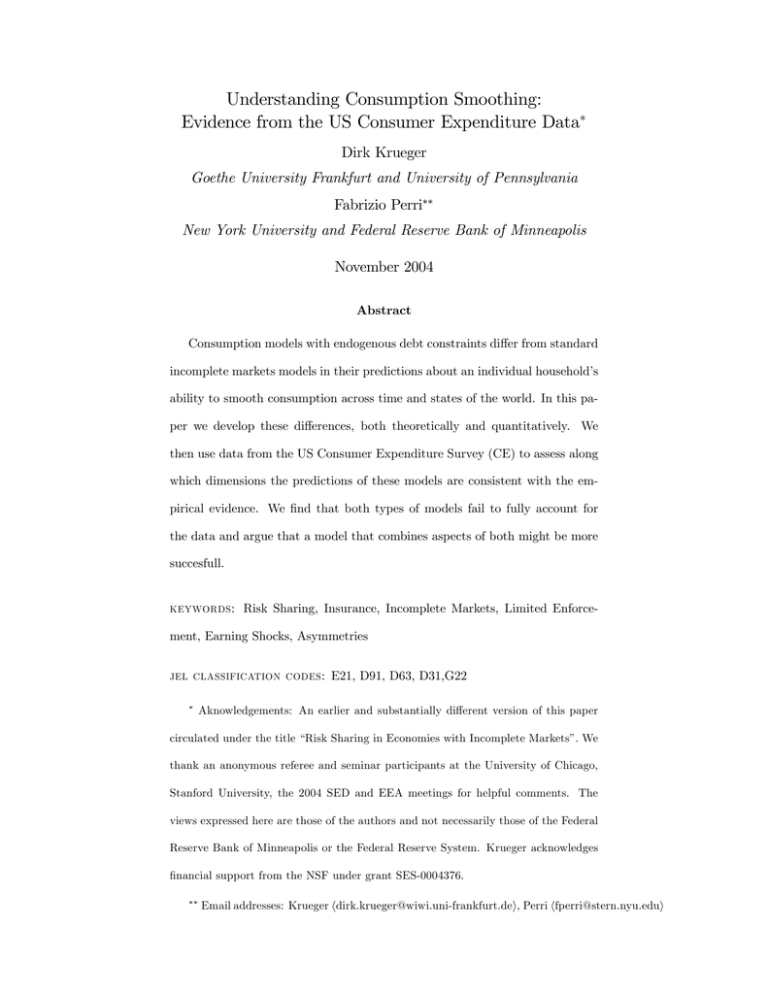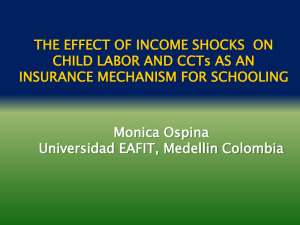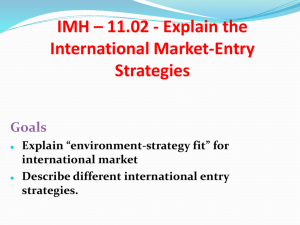Understanding Consumption Smoothing: Evidence from the US Consumer Expenditure Data
advertisement

Understanding Consumption Smoothing:
Evidence from the US Consumer Expenditure Data∗
Dirk Krueger
Goethe University Frankfurt and University of Pennsylvania
Fabrizio Perri∗∗
New York University and Federal Reserve Bank of Minneapolis
November 2004
Abstract
Consumption models with endogenous debt constraints differ from standard
incomplete markets models in their predictions about an individual household’s
ability to smooth consumption across time and states of the world. In this paper we develop these differences, both theoretically and quantitatively. We
then use data from the US Consumer Expenditure Survey (CE) to assess along
which dimensions the predictions of these models are consistent with the empirical evidence. We find that both types of models fail to fully account for
the data and argue that a model that combines aspects of both might be more
succesfull.
keywords: Risk Sharing, Insurance, Incomplete Markets, Limited Enforcement, Earning Shocks, Asymmetries
jel classification codes: E21, D91, D63, D31,G22
∗
Aknowledgements: An earlier and substantially different version of this paper
circulated under the title “Risk Sharing in Economies with Incomplete Markets”. We
thank an anonymous referee and seminar participants at the University of Chicago,
Stanford University, the 2004 SED and EEA meetings for helpful comments. The
views expressed here are those of the authors and not necessarily those of the Federal
Reserve Bank of Minneapolis or the Federal Reserve System. Krueger acknowledges
financial support from the NSF under grant SES-0004376.
∗∗
Email addresses: Krueger hdirk.krueger@wiwi.uni-frankfurt.dei, Perri hfperri@stern.nyu.edui
1
Introduction
If complete insurance markets were available to households they could insulate their
consumption profile from idiosyncratic income risk. This prediction is commonly
rejected empirically. In response to this finding a number incomplete risk sharing
models have been developed. In many models imperfect risk sharing arises since
agents can only trade a single, uncontingent bond and face borrowing constraints.1
We refer to this setup as the standard incomplete markets model (SIM). Another
class of models assume that a full set of state contingent contracts is available to
all agents, but that intertemporal contracts can only be legally enforced by exclusion from future intertemporal trade.2 Since exclusion from credit markets is not
infinitely costly in some states of the world agents might find optimal not to repay
their debts and go into autarky. This possibility endogenously restrict the extent to
which each contingent asset can be traded and thus limits risk sharing. We refer to
this model as the debt constrained markets model (DCM).
In this paper we argue that both types of incomplete risk-sharing models have
different, empirically testable implications for the response of consumption growth to
idiosyncratic income fluctuations. We demonstrate that a reasonably parameterized
version of the SIM model predicts a substantial deviation from perfect consumption
insurance, whereas the DCM model predicts a modest deviation. We compare these
implications with the United States Consumer Expenditure Survey (CE) data and
find that the DCM model does a better job in explaining the data.
A second dimension along which both models differ in their empirical implications is the asymmetric response of consumption to income shocks. Both models
1
See Deaton (1991) or Aiyagari (1994), among others.
2
See for example Kehoe and Levine (1993) or Alvarez and Jermann (2000).
1
predict that consumption growth responds stronger to positive than to negative
income growth rate shocks of similar magnitude, but these responses are quantitatively and qualitatively different in both models. Here we discuss why both models
predict these asymmetries and then investigate whether the data bear out the asymmetries as predicted by both models; we find that in the data the response is quite
symmetric so neither model seems to able to account for the data.
In sections 2, 3 and 4 we briefly review the two models, characterize some features
of the allocations and discuss the choice of parameters. Our results are contained
in section 5 and section 6 concludes.
2
The Environment
There is a continuum of identical infinitely lived consumers who obtain period utility
u(.) from consuming a single non storable good. Let β be the discount factor. Each
individual has a stochastic endowment process, and we denote by yt the current
period endowment and by yt = (y0 , .., yt ) the history of realizations of endowment
shocks. yt follows a stationary Markov process with transition probabilities π(y 0 |y)
and unique invariant measure Π(.). We use the notation y s |y t to mean that y s is a
possible continuation of endowment shock realization yt . At date 0 agents are distinguished by their initial asset holdings a0 and their initial shock y0 . A consumption
allocation {ct (a0 , y t )} specifies how much to an agent of type (a0 , y0 ) consumes,
conditional on experiencing history y t .
2
2.1
Market Structures
The two incomplete markets models whose predictions we will test differ along two
dimensions: the set of assets that can be traded and the short-sale constraints these
trades are subject to. Within the SIM model agents face budget constraints of the
form
ct (a0 , y t ) +
at+1 (a0 , y t )
= at (a0 , y t−1 ) + yt
Rtin
where Rtin is the gross interest rate on one-period risk-free bonds. Agents face
borrowing constraints of the form at+1 (a0 , y t ) ≥ −Ā, where Ā is a fixed parameter.
In the DCM model consumers can trade a full set of state contingent commodities. Their budget constraints is
ct (a0 , y t ) +
X
qt (a0 , yt , yt+1 )at+1 (a0 , y t ) = at (a0 , y t ) + yt
yt+1
where qt (a0 , yt , yt+1 ) is the price of a claim to consumption in period t + 1 for a
household with characteristics (a0 , y t ), conditional on shock yt+1 being realized.
The feature that separates the DCM model from a complete markets model is
the presence of individual rationality (or “debt constraints” as Kehoe and Levine
(1993) called them): consumers have the option of opting out of intertemporal trade
and renege on their debt. The only punishment for doing so, and hence the only
enforcement mechanism for contracts, is that agents that choose to default on their
contracts are banned from future intertemporal trade. This assumption together
with the existence of the full set of securities impose the following set of enforcement
constraints on equilibrium allocations
¡
¢ X X s−t
u c(a0 , yt ) +
β π(y s |y t )u (c(a0 , y s ))
s>t ys |yt
≥ u (yt ) +
XX
s>t y s |y t
β s−t π(ys |y t )u (ys ) ≡ U Aut (yt )
3
∀y t
(1)
2.2
Recursive Formulation
For the DCM model one can exploit duality theory to characterize allocations as
solutions to a cost minimization problem of a social planner that faces a constant
interest rate R and has to deliver lifetime utility w to the agent. The planner solves
⎫
⎧
⎬
⎨
X
1
V (w, y) =
min
π(y 0 |y)V (g(y0 ), y 0 )
c+
⎭
R 0
c≥0,{g(y0 )} ⎩
(2)
y ∈Y
s.t.
w = (1 − β)u(c) + β
g(y 0 ) ≥ U Aut (y 0 )
X
y0 ∈Y
π(y 0 |y)g(y 0 )
(3)
∀y 0 ∈ Y
(4)
where V (w, y) is the resource cost for the planner to provide an individual with
expected utility w when the household’s endowment is y and
1
R
is the relative price
of future resources in terms of current resources. The cost consists of the cost of
consumption c today and expected cost from tomorrow on,
P
y0
π(y0 |y)V (g(y0 ), y0 ),
discounted to today, where g(y 0 ) represents the utility promises received by the
household next period if its future income is y 0 . The promise-keeping constraint (3)
ensures that an individual entitled to w in fact receives utility w through the allocation c, {g(y 0 )}y0 ∈Y . The participation constraints (4) state that the social planner
for each state tomorrow has to guarantee individuals an expected utility promise at
least as high as obtained with the autarkic allocation U Aut (yt ).
The definition of a recursive competitive equilibrium and a stationary equilibrium is standard in both models and hence omitted.3
3
For the standard incomplete markets model, see Aiyagari (1994), for the debt constrained
markets model, see Krueger and Perri (1999).
4
3
Qualitative Features of the Models
3.1
Standard Incomplete Markets
It is in general hard to obtain sharp characterizations of consumption allocations in
the SIM model. If households have quadratic period utility functions, the borrowing
constraints are loose enough to never be binding and βRin = 1, then we are in the
special case of the permanent income hypothesis (PIH) and consumption equals
permanent income. In this case, if current income declines and increases affect
permanent income in a symmetric fashion, consumption responds to both income
declines and to income increases, and it does so in a symmetric way.
For a more general specification of the utility function and/or binding borrowing
constraints is possible to show that individual consumption responds to income
fluctuations (because of partial insurance) and that, on average, it responds more
to income increases than to income declines. The two features that generate this
asymmetry are that the household’s optimal consumption function is concave in
cash at hand4 and that the income process is mean reverting. Note that households
with low income have, on average, low cash at hand and, because mean reversion
in income, high income growth. Similarly high income households tend to have
high cash at hand and negative income growth. The concavity of the consumption
function then insures that the consumption increases associated with the income
increases of the low income households are larger than the consumption declines
associated with the income declines of the high income households
4
See Carroll and Kimball (1996)
5
3.2
Debt Constrained Markets
The first order and envelope conditions of problem (2) imply that5
u0 (c) ≥ βRu0 (c0 (y 0 ))
=
if g(y 0 ) > U Aut (y0 )
(5)
where c0 (y0 ) represents optimal consumption next period. That is, in states in which
the limited enforcement constraint is not binding the planner allocates consumption
to the agent according to a full insurance (complete markets) Euler equation.
The crucial difficulty in characterizing the optimal consumption allocations in
this model is then to identify the states in which the limited enforcement constraints
are not binding, and states in which they are binding. Krueger and Perri (1999)
obtained the following theoretical characterization of the optimal policy function
g(w, y; y 0 ) for the i.i.d. case, for which g(w, y; y 0 ) = g(w; y 0 ), under the assumption
that βR < 1.6
Proposition 1
1. For each y 0 tomorrow, the participation constraint is binding
or utility promises are decreasing over time: g(w, y 0 ) < w for all w > U Aut (y 0 )
and g(w, y 0 ) = U Aut (y 0 ) for all w ≤ U Aut (y 0 ).
2. Promises are equalized when possible and increased when the participation constraints bind: If y 0 > ŷ 0 , then g(w, y0 ) ≥ g(w, ŷ0 ). If g(w, y 0 ) > U Aut (y0 ) and
g(w, ŷ 0 ) > U Aut (ŷ 0 ), then g(w, ŷ0 ) = g(w, y0 ) > U Aut (y0 ).
3. c(w) is strictly increasing in w.
5
Krueger and Perri (1999) prove, for the case that income shocks are iid, that the value function
is differentiable. Here we go ahead and assume it for the general discussion.
6
We also show that if full insurance is not enforceable, an equilibrium satisfies βR < 1.
6
Notice first that, if the constraints for low income states are binding, they are
also binding for high income states. Second, for the states for which the constraints
are not binding, consumption drifts down at a common rate. For example, if the
utility function is of CRRA form, then (5) becomes
log(c0 ) − log(c) ≥
1
log(βR)
σ
with equality if g(y0 ) > U Aut (y 0 ). This equation is the basis for the asymmetric
response of consumption to income shocks: if income falls, consumption drifts down
at rate
1
σ
log(βR) < 0 and the individual growth rate of consumption is independent
of the actual income decline. If income increases the participation constraint is
binding, consumption growth is positive and the size of consumption growth depends
on the size of income growth.
3.3
Testable implications
To describe the extent of risk allocation of income shocks Mace (1991), and Dynarski
and Gruber (1997) run the following regression on the universe of CE data (which
contains a short rotating panel for both households’ income yit and consumption
cit )
∆ log cit = α1 + α2 ∆ log yit + α3 time dummies + βXit + εit
(6)
where Xit are controls for changes in household composition, seasonal and age effects
and εit represents measurement error. The size of the coefficient α2 can be interpreted as a measure of the extent of risk allocation for household income shocks.
Similarly, in order to test for the asymmetries predicted by both models we run the
regression above restricting the sample to only households who experience positive
−
(negative) income growth. We denoted by α+
2 (α2 ) the coefficient in this type of
7
regression In table 1 we summarize the model predictions for the regression coefficients above, which we will compare to the empirical results from CE data. For
reference we include also the predictions in the case of absence of credit markets
(autarky) and in the case of perfect risk sharing (complete markets).
Table 1: Consumption Response to Income Shocks
α2
α−
2
α+
2
1
1
1
Standard Incomplete Markets
>0
>0
>> 0
Debt Constrained Markets
>0
0
>0
0
0
0
Model
Autarky
Complete Markets
4
Calibration
The stochastic endowment process, which represents households’ income shocks, is
specified as finite state discretization of an AR(1) process as in Aiyagari (1994) and
Heaton and Lucas (1996):
log(y 0 ) = ρ log(y) + ε
where ε ∼ iidN (0, σ 2ε ). Not all cross-sectional income differences in the data are due
to stochastic idiosyncratic income shocks however, but rather to cross-household
differences in composition, education and other observable permanent factors. In
order to account for this fact we first regress per capita household earnings from CE
on age, race, sex and education dummies. We then interpret the residuals from this
regression as idiosyncratic household income. As a benchmark for the persistence
parameter we choose ρ = 0.98, which is the value estimated by Storesletten et al.
(2004) using data from the Panel Study for Income Dynamics. We then choose σ 2ε
to match the cross-sectional variance of idiosyncratic household income in the CE
8
in 1991, the midpoint of our sample. This cross-sectional variance is 0.719.7 . In the
SIM model we also need to specify the borrowing limit Ā, which corresponds to the
upper limit on uncollateralized loans. A reasonable benchmark borrowing limit may
be taken as one year’s average income, that is Ā = 1 but we also experiment with
Ā = 4. Finally with respect to preferences, we choose a log-utility function and pick
the time discount factor β so that the stationary equilibrium in each model produces
a real interest rate of 2.5%.
5
Results
−
Table 2 reports our estimates of α2 , α+
2 and α2 on CE data and simulated data
from calibrated versions of both models.8 We include all households in the CE
that are classified as complete income respondents, whose reference person is of
age between 21 and 64, and which report positive labor earnings and consumption
in their 2nd and 5th interview (which is the first and last time each household is
interviewed). Our sample starts in the first quarter of 1980 and ends in the first
quarter of 2003. For the data we report both OLS estimates as well as instrumental
variables estimates. For the latter, the CE contains two independent observations
of household income, one that directly relies on income responses, and one that can
be constructed based on information for income from the last pay check as well as
hours worked. To tackle the problem of measurement error in income growth which
7
Due to space limitations we have to refer the reader to our detailed description of this procedure
in Krueger and Perri (2002).
8
Our consumption definition is expenditures on nondurables plus imputed service flow form
consumer durables and our and income definition is labor earnings minus taxes, plus transfers. For
more details please see Krueger and Perri (2002).
9
may bias the estimates for the income coefficient downward we instrument the first
income growth measure by the second.9 The first three columns in the first row
suggest that the DCM model predicts a substantially better risk allocation than the
SIM model. From the CE data, we find that perfect insurance is rejected on statistical grounds: in response to a 1% change in income consumption changes range from
0.04% (using OLS estimates) to 0.14% (using IV estimates).10 Finally, comparing
data to model results we conclude that while the DCM model slightly under-predicts
the consumption response to income shocks, the SIM model grossly over-predicts
it, regardless of whether one trusts the OLS estimates or the IV estimates. The
last two rows of the table suggest that in the data the response of consumption to
positive income shocks is not statistically different from the response to negative
income shocks, thus contradicting the asymmetries predicted by both models. The
PIH model, described in section 3 above, would perhaps be able to do a better job
in accounting for this symmetric pattern of the data. In the next section we assess
two simple extensions of the models discussed so far.
9
10
Our procedure follows Dynarsky and Gruber (1997); see their detailed discussion.
In recent work Klein and Gervais (2004) argue that, due to timing differences in the reporting
of income, the IV estimator is likely to be biased upward. Thus the true value for α2 may lie
between the OLS and the IV estimate.
10
+
Table 2: Estimates of α2 , α−
2 , α2 (35157 observations, S.E. in parentheses)
# of cases
Coef.
DCM
SIM, Ā = 1
SIM, Ā = 4
35157
α̂2
0.02
0.87
0.69
16056
19101
5.1
α̂−
2
α̂+
2
0.00
0.06
0.78
0.92
CEX (OLS)
CEX (IV)
0.04
0.14
(0.003)
(0.011)
0.04
0.15
(0.004)
(0.018)
0.03
0.14
(0.004)
(0.017)
0.56
0.80
Sensitivity analysis
We first consider the case in which individuals who default are banned from trading
risk sharing contracts and from borrowing forever, but are allowed to save at an
interest rate 1 + r, starting out with zero savings. Allowing agents to save helps
them to self-insure against income fluctuations in autarky. Therefore the utility
from being in autarky increases and less risk sharing is enforceable in equilibrium.
The extent to which risk sharing declines with the introduction of saving depends
on r. If we set r = −1 then the model coincides with no-saving case, but if we allow
agents to save at the market interest rate of 2.5% after default, the estimates of α2
in the model quadruples from 0.022 to 0.088 (see the first row of table 4) which is
quite close to the coefficient estimated in the data. Still, even in this case the model
predicts, contrary to the data, a significant asymmetry in the consumption response
to income changes.
Another crucial parameter determining the extent of risk allocation is the persistence of the income shocks. Holding the variance of income shocks fixed, higher
persistence of income shocks affect both models. In the DCM model the value of
11
autarky increases for high income realizations (that is, those constraints that tend
to be binding), leading to reduced risk sharing and thus a higher coefficient α2 .
On the other hand in the SIM model more persistent income shocks are harder to
self-insure, again suggesting α2 to increase with persistence ρ.
Table 3: Estimates of α2 as Function of ρ
Pers. ρ
DCM, r = −1
DCM, r = 0.025
SIM, Ā = 1
0.98
0.02
0.09
0.87
0.93
0.02
0.07
0.81
0.53
0.00
0.03
0.43
Table 3 shows α̂2 as a function of persistence ρ for both models.11 As conjectured
above in both models less persistent income shocks are easier to (self-) insure. Even
for low persistence, the SIM model still predicts a consumption response to income
shocks much higher than the one observed in the data.12 The table thus suggests
that the DCM model gets closer to the data with very persistent income shocks
while the SIM model does a better job with low persistence income shocks.
6
Conclusions
We studied quantitative versions of two popular partial risk-sharing models and
found that neither model can capture the actual consumption response to income
fluctuations of US households. The DCM model, due to the presence of insurance
markets predicts that households’ consumption should be perfectly insulated from
11
We always re-calibrate β and σ2ε to match the interest rate and the cross-sectional earnings
variance in the data.
12
The variance σ2ε for a ρ = 0.53 required to match the cross-sectional income variability from
the data is so substantial that the borrowing constraint of Ā = 1 constitutes the natural borrowing
constraint, as defined in Aiyagari (1994).
12
income declines and this does not seem true in the data. On the other hand the
SIM model, due to the lack of insurance markets, predicts that consumption of US
households should react to income shocks much more than it actually does, even
when an income process with relatively low persistence is used. One lesson we learn,
which echoes recent findings of Blundell et al (2002) and Storesletten et al (2004),
is that a set-up which combines aspects of both models could be most helpful in
understanding consumption smoothing in the US.
References
Aiyagari, Rao (1994), “Uninsured Idiosyncratic Risk and Aggregate Saving,”
The Quarterly Journal of Economics, 109, 659-684
Alvarez, Fernando and Urban Jermann (2000), “Efficiency, Equilibrium, and
Asset Pricing with Risk of Default,” Econometrica, 68, 775-798
Blundell Richard, Luigi Pistaferri and Ian Preston (2002), “Information, partial
insurance and consumption dynamics”, University College of London
Carroll, Christopher and Miles Kimball (1996), “On the Concavity of the Consumption Function,” Econometrica, 64, 981-992
Deaton, Angus (1991), “Saving and Liquidity Constraints,” Econometrica, 59,
1221-48
Dynarski, Susan and Jonathan Gruber (1997), “Can Families Smooth Variable
Earnings?,” Brookings Papers on Economic Activity, 229-284
Heaton, Jonathan and Deborah Lucas (1996), “Evaluating the Effects of Incomplete Markets on Risk Sharing and Asset Pricing,” Journal of Political Economy,
104, 443-487
Kehoe, Timothy and David Levine (1993), “Debt Constrained Asset Markets,”
13
Review of Economic Studies, 60, 865-888
Klein Paul and Martin Gervais (2004), “Risk Sharing”, University of Western
Ontario
Krueger, Dirk and Fabrizio Perri (1999), “Risk Sharing: Private Insurance Markets or Redistributive Taxes?,” Federal Reserve Bank of Minneapolis Staff Report
262.
Krueger, Dirk and Fabrizio Perri (2002), “Does Income Inequality Lead to Consumption Inequality? Evidence and Theory,” NBER working paper 9292
Mace, Barbara (1991), “Full Insurance in the Presence of Aggregate Uncertainty,” Journal of Political Economy, 99, 928-56
Storesletten, Kjetil, Chris Telmer and Amir Yaron (2004), “Consumption and
Risk Sharing over the Life Cycle”, Journal of Monetary Economics, 2004, vol. 51,
609-633
14




